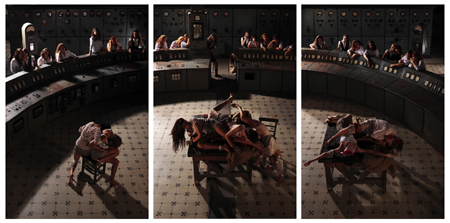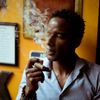A comment on Middle Eastern art through the lens of Art, The Arts, and Policy
To see certain things, we squint. In response to a glare, we omit the details of a scene by nearly closing our eyes and looking through the shade of brows and lashes to render a visual average: the broad shapes, the main roads. We squint at the Middle East.
The glare in this case is the unbroken beam of light shone squarely in our faces by turbulent politics, war, and soundbitten regurgitations of what is called news. So, in the grand scheme, Tunisia, Egypt, and the glaring Middle East today are at once new and familiar. To begin to understand the light, you could go back a few thousand years to Abraham, Sarah... and, principally, to their children, Isaac and Ishmael.
The point? We should be well past squinting, now simply reaching for our sunglasses. The world outside of the United States has long been able to filter the glare of this superpower and go about business, if only out of necessity. We're too far along to deal clumsily in the broad shapes and main roads of the Middle East, the trade-off being a self-imposed ignorance that falsely separates the human experience into "us" and "them." They are us.
[enter] ZOOM (a pair of sunglasses)
ZOOM is the first American art fair to focus on contemporary art from the Middle East. Let that sink in. Director and Founder Angeliki Georgiou staged the fair at Art Basel Miami Beach last December. I'm writing a couple of months later in an attempt to extend the show to our minds. So, here's the scene: Take the full region, Including Israel, and imagine it as a field-grown tree, root-balled, and then planted in the frenzy of the world's most talked about art fair. A formidable undertaking for any curator, but it worked: From internationally collected artists to emerging talents, the narrative escaped the tiny and expected political box and pointed to the lovely and difficult infinities you would expect Art to do. But, many visitors missed that.

Triptych, c-print mounted on foam, AP1, 180 x 120 cm each, 2009.
Courtesy of Green Art Gallery, Dubai
Some didn't, and some of those bought. A light buzz even hit the street among other gallerists at other fairs: "Go see it!" But at ZOOM, I found a viable case study in the problem Edward Said elaborates here in Reflections on Exile. (Just substitute "art" for "literature.")
To value literature at all is fundamentally to value it as the individual work of an individual writer tangled up in circumstances taken for granted by everyone, such things as residence, nationality, a familiar locale, language, friends, and so on. The problem for the interpreter, therefore, is how to align those circumstances with the work, how to separate them, as well as how to incorporate them, how to read the work and its worldly situation.
But we're not there yet with Middle Eastern art. We squint. I discovered this while walking the fair and speaking to each of the gallerists and listening for reactions. Here's a sampling of the themes repeated by many visitors:
"This isn't Turkish art." "Where is the empowerment of women?" "I don't see this as Middle Eastern."
You could sum them up with, "Hey, who moved my stereotype?!"
I wouldn't be shocked if we weren't dealing with Art Basel Miami Beach, a gathering known to attract the world's most knowledgeable and passionate group of collectors, curators, and thought leaders. But, we're not yet ready to bring the same critical lens to the stuff we just call art, i.e. the things themselves, without facile ethnic or cultural adjective. But this isn't new. Art by a black person in the United States is sometimes called "black" though a tree in a painting may just be a tree, not a "black" tree. From here, do you really think we're in a position to see Mark Bradford's work as a self-styled "post-black" artist?
Don't take this as a chastising. Sure, Edward Said stated the task easily enough, but I don't think it's easy amid the glare to become skilled at "reading" art. That's one of the joys: You can spend eternity with it if it is true, alternately incorporating culture into a work or separating it from the work en route to some understanding. I enjoy that kind of thinking because it adds dimension and depth to the pieces that strike me. That's worlds away from art-by-phenotype.
This is not a crisis for Middle Eastern artists (that we don't get it). The art market in the region is a vibrant one with collectors moving fluidly between the individual and his or her context, or just using the base "I like it" criterion as the sole motivation to buy. I'm positing this case as an opportunity for Middle Eastern artists and for new markets, particularly the West and its U.S. epicenter.
I'm not telling you to go click a "Like" button for Middle Eastern art. Rather, you should treat it simply as... art, putting culture in its proper place by avoiding the reflex of judging, praising or dismissing a work simply on the basis of origin. Culture should always be subservient to the inherent genius of true art: Ask yourself if it moves you, if it's true... not who did it. But since we're just human, and born into distinct "worldly situations," of course culture has a place. It's the medium and catalyst for that genius.
Now, we can re-enter ZOOM and welcome the tightly-woven discourse of a Lebanese artist born in London, raised in Nigeria, and schooled in Beirut and New York: Zena el Khalil. We could understand William Wells' account of the early difficulty of Cairo's energetic and now massive art hub, Townhouse, in earning the trust of young independent artists who at first didn't want to show there, and then see the relation of those attitudes to the current Egyptian revolution. We could dwell for a while on Shoja Azari's "There Are No Non-Believers In Hell." We could pose questions to the young Moroccan artist, Zakaria Rahmani, who doesn't paint, per se. He "writes" paintings in calligraphy. Leila Heller of LTMH calls the U.S. "the last untapped market for Middle Eastern art," and thus, she describes her gallery as an "island" in the West.
This is a conversation waiting to take off. ZOOM, in retrospect, could mark a real moment for that.
...
3 questions for the Founder & Director, Angeliki Georgiou:
What was your biggest positive surprise during the show?
The lively and stimulating conversations between ZOOM exhibitors, artists, curators, and scholars during breakfast.
To what starting point would you guide a collector?
Go to as many exhibitions as possible, talk to the artists, and read the reviews/critical responses.
What's next?
Planning ZOOM Contemporary Art Fair 2011. ZOOM will again take the lead in increasing awareness and enhancing exposure of contemporary art from the Middle East to new audiences.

